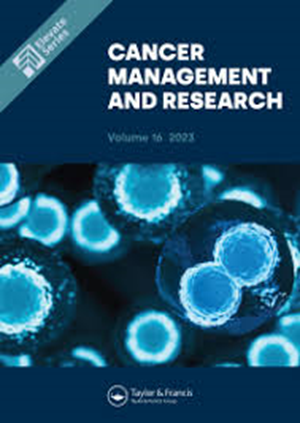使用 N-二乙基亚硝胺和苯巴比妥诱导常规家猪肝细胞癌
IF 2.5
4区 医学
Q3 ONCOLOGY
引用次数: 0
摘要
目的:由于大型动物模型与人类相似,因此许多研究仍在使用大型动物模型。目前还没有文献表明,通常为肉类生产而饲养的普通大小的常规农场种猪可用于生成肝细胞癌(HCC)动物模型。本研究的目的是调查N-二乙基亚硝胺(DENA)和苯巴比妥(PB)如何在普通养殖猪中共同产生HCC:材料和方法:使用常规家猪(Sus scrofa domesticus)。每周腹腔注射15毫克/千克的DENA,连续12周;同时通过食物给药4毫克/千克的PB片剂,连续16周。进行血液检测和超声波评估以监测病情进展。随后,对疑似结节的病例进行计算机断层扫描,并进行组织病理学检查以确诊:本研究共纳入 10 头猪(7 头雄性,3 头雌性;年龄:2 个月;体重:9-15 千克),并对其进行了 25 个月的随访;出于伦理考虑,其中 9 头为实验猪,1 头为对照组。研究期间,动物的最大体重达 162- 228 千克。干预组猪的增重主要低于对照组。实验室分析显示,肝功能指标没有明显异常,但尿素(p = 0.028)和肌酐(p = 0.003)水平的变化具有统计学意义。超声波检查和计算机断层扫描显示多发性肝结节,其特征与 HCC 相似。连续的成像筛查和更长时间的观察显示,所有动物最终都患上了肿瘤。诱导后 15-22 周的组织病理学确认显示,所有接受干预的猪都出现了分化良好的 HCC 多发结节,有些还出现了肝血管肉瘤:本研究利用DENA和PB组合成功地在常规家猪中诱发了HCC。这项研究至少需要 15 个月的时间才能形成肿瘤。关键词:致癌;大型动物模型;肝细胞癌;家猪;DENA诱导本文章由计算机程序翻译,如有差异,请以英文原文为准。
Induction of Hepatocellular Carcinoma in Conventional Domestic Swine Using N-Diethylnitrosamine and Phenobarbital
Purpose: Large animal models are still used in many studies because of their likeness to humans. It has not been documented that regular-sized conventional farm-breed pigs, generally bred for meat production, can be used to generate hepatocellular carcinoma (HCC) animal models. The goal of this study was to investigate how N-diethylnitrosamine (DENA) and phenobarbital (PB) together can generate HCC in ordinary farmed pigs.
Materials and Methods: Conventional domestic swine (Sus scrofa domesticus) were used. DENA 15 mg/kg was intraperitoneally injected weekly for 12 weeks, while PB tablets (4 mg/kg) were also administered through food for 16 weeks. Blood testing and ultrasonography evaluation were performed to monitor the progress. Subsequently, computed tomography was conducted in cases with suspected nodules, followed by histopathological examination to confirm the diagnosis.
Results: Ten swine (seven males, three females; age: 2 months; weight: 9– 15 kg) were included in the study and followed up for 25 months; nine were experimental, and one was control for ethical considerations. The maximum weight of animals during this study reached 162– 228 kg. The weight gain seen in the intervention swine was predominantly lower than that documented in the control. The laboratory analysis revealed no notable abnormalities in liver function markers but did demonstrate statistically significant changes in urea (p = 0.028) and creatinine (p = 0.003) levels. Ultrasonography and computed tomography showed multiple liver nodules with characteristics resembling HCC. Serial imaging screening and more extended observations revealed that all animals eventually developed tumors. Histopathological confirmation at 15– 22 weeks post-induction revealed that all intervened swine developed multiple nodules of well-differentiated HCC and some with hepatic angiosarcoma.
Conclusion: This study successfully generated HCC in conventional domestic swine with a DENA and PB combination. This investigation required at least 15 months to develop tumors. This model will be beneficial for future investigations of HCC in large animals.
Keywords: carcinogenesis, large animal model, hepatocellular carcinoma, domestic swine, DENA induction
Materials and Methods: Conventional domestic swine (Sus scrofa domesticus) were used. DENA 15 mg/kg was intraperitoneally injected weekly for 12 weeks, while PB tablets (4 mg/kg) were also administered through food for 16 weeks. Blood testing and ultrasonography evaluation were performed to monitor the progress. Subsequently, computed tomography was conducted in cases with suspected nodules, followed by histopathological examination to confirm the diagnosis.
Results: Ten swine (seven males, three females; age: 2 months; weight: 9– 15 kg) were included in the study and followed up for 25 months; nine were experimental, and one was control for ethical considerations. The maximum weight of animals during this study reached 162– 228 kg. The weight gain seen in the intervention swine was predominantly lower than that documented in the control. The laboratory analysis revealed no notable abnormalities in liver function markers but did demonstrate statistically significant changes in urea (p = 0.028) and creatinine (p = 0.003) levels. Ultrasonography and computed tomography showed multiple liver nodules with characteristics resembling HCC. Serial imaging screening and more extended observations revealed that all animals eventually developed tumors. Histopathological confirmation at 15– 22 weeks post-induction revealed that all intervened swine developed multiple nodules of well-differentiated HCC and some with hepatic angiosarcoma.
Conclusion: This study successfully generated HCC in conventional domestic swine with a DENA and PB combination. This investigation required at least 15 months to develop tumors. This model will be beneficial for future investigations of HCC in large animals.
Keywords: carcinogenesis, large animal model, hepatocellular carcinoma, domestic swine, DENA induction
求助全文
通过发布文献求助,成功后即可免费获取论文全文。
去求助
来源期刊

Cancer Management and Research
Medicine-Oncology
CiteScore
7.40
自引率
0.00%
发文量
448
审稿时长
16 weeks
期刊介绍:
Cancer Management and Research is an international, peer reviewed, open access journal focusing on cancer research and the optimal use of preventative and integrated treatment interventions to achieve improved outcomes, enhanced survival, and quality of life for cancer patients. Specific topics covered in the journal include:
◦Epidemiology, detection and screening
◦Cellular research and biomarkers
◦Identification of biotargets and agents with novel mechanisms of action
◦Optimal clinical use of existing anticancer agents, including combination therapies
◦Radiation and surgery
◦Palliative care
◦Patient adherence, quality of life, satisfaction
The journal welcomes submitted papers covering original research, basic science, clinical & epidemiological studies, reviews & evaluations, guidelines, expert opinion and commentary, and case series that shed novel insights on a disease or disease subtype.
 求助内容:
求助内容: 应助结果提醒方式:
应助结果提醒方式:


